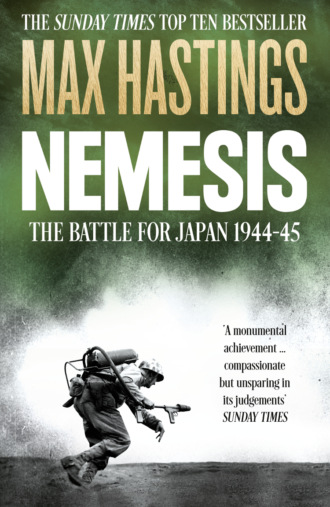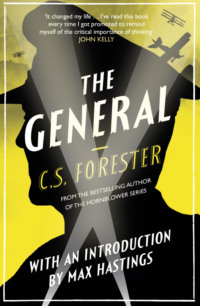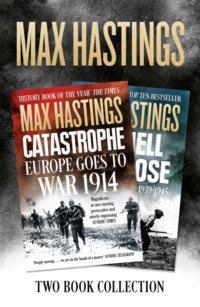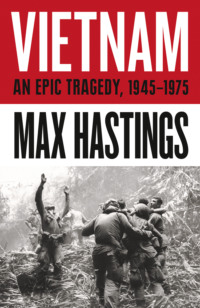
Полная версия
Nemesis: The Battle for Japan, 1944–45
Oral evidence collected in the early twenty-first century by interviewing men and women who witnessed events more than sixty years earlier is immensely valuable in illustrating moods and attitudes. But old people have forgotten many things, or can claim to remember too much. Those who survive today were very young in the war years. They held junior ranks and offices, if indeed any at all. They knew nothing worth rehearsing about events beyond their own eyesight and earshot. The reflections of their age group cannot be considered representative of a nation’s mindset and behaviour in 1944-45. It is essential to reinforce their tales with written testimony from those who were at the time more mature and exalted.
It is notable how swiftly historical perceptions change. For instance, in post-war Japan General Douglas MacArthur was a hero, an icon, almost a god, in recognition of his perceived generosity to the Japanese people in defeat. But a modern historian, Kazutoshi Hando, says: ‘In Japan today, MacArthur is almost unknown.’ Similarly, a Chinese historian told me that few of his young compatriots have heard of Stalin. I feel obliged to restate a caveat which I entered in the foreword of Armageddon: statistics given here are the best available, but all large numbers related to the Second World War must be treated warily. Figures detailing American and British activities—though emphatically not their contemporary estimates of losses inflicted on the enemy—are credible, but those of other nations are disputed, or represent guesstimates. For instance, although the rape of Nanjing falls outside the compass of my narrative, I am persuaded that Iris Chang’s well-known book claims a death toll for the city in excess of its actual, rather than previously recorded, 1937 population. This does not invalidate the portrait of horror which she depicts, but it illustrates the difficulty of establishing credible, never mind conclusive, numbers.
The longer I write books about the Second World War, the more conscious I become that a fundamental humility is necessary when offering judgements upon those who conducted it. Harold Macmillan, British minister in the Mediterranean 1943-45 and later prime minister, once told me a story of his last encounter with Field Marshal Earl Alexander, wartime Allied commander-in-chief in Italy: ‘We were going into the theatre together, and I turned to him and said one of those old man’s things: “Alex, wouldn’t it be lovely to have it all to do over again.” Alexander shook his head decisively. “Oh, no,” he said. “We might not do nearly so well.”’ Those of us who have never been obliged to participate in a great war seem wise to count our blessings and incline a bow to all those, mighty and humble, who did so.
MAX HASTINGS
Hungerford, England and Kamogi, Kenya
April 2007
1 Dilemmas and Decisions
1 WAR IN THE EAST
Our understanding of the events of 1939-45 might be improved by adding a plural and calling them the Second World Wars. The only common strand in the struggles which Germany and Japan unleashed was that they chose most of the same adversaries. The only important people who sought to conduct the eastern and western conflicts as a unified enterprise were Franklin Roosevelt, Winston Churchill and their respective chiefs of staff. After the 7 December 1941 Japanese attack on Pearl Harbor caused the United States to become a belligerent, Allied warlords addressed the vexed issue of allocating resources to rival theatres. Germany was by far the Allies’ more dangerous enemy, while Japan was the focus of greater American animus. In 1942, at the battles of the Coral Sea in May and Midway a month later, the US Navy won victories which halted the Japanese advance across the Pacific, and removed the danger that Australia might be invaded.
Through the two years which followed, America’s navy grew in strength, while her Marines and soldiers slowly and painfully expelled the Japanese from the island strongholds which they had seized. But President Roosevelt and Gen. George Marshall, chairman of the joint chiefs of staff, resisted the demands of Admiral Ernest King, the US Navy’s C-in-C, and of Gen. Douglas MacArthur, supreme commander in the south-west Pacific, for the eastern theatre to become the principal focus of America’s war effort. In 1943 and 1944, America’s vast industrial mobilisation made it possible to send large forces of warships and planes east as well as west. Most US ground troops, however, were dispatched across the Atlantic, to fight the Germans. Once Japan’s onslaught was checked, the Allies’ eastern commanders were given enough forces progressively to push back the enemy, but insufficient to pursue a swift victory. The second-class status of the Japanese war was a source of resentment to those who had to fight it, but represented strategic wisdom.
The US and Britain dispatched separate companies to Europe and Asia, to perform in different plays. Stalin, meanwhile, was interested in the conflict with Japan only insofar as it might offer opportunities to amass booty. ‘The Russians may be expected to move against the Japanese when it suits their pleasure,’ suggested an American diplomat in an October 1943 memorandum to the State Department, ‘which may not be until the final phases of the war—and then only in order to be able to participate in dictating terms to the Japanese and to establish new strategic frontiers.’ Until 8 August 1945, Soviet neutrality in the east was so scrupulously preserved that American B-29s which forced-landed on Russian territory had to stay there, not least to enable their hosts to copy the design.
To soldiers, sailors and airmen, any battlefield beyond their own compass seemed remote. ‘What was happening in Europe really didn’t matter to us,’ said Lt John Cameron-Hayes of 23rd Indian Mountain Artillery, fighting in Burma. More surprising was the failure of Germany and Japan to coordinate their war efforts, even to the limited extent that geographical separation might have permitted. These two nominal allies, whose fortunes became conjoined in December 1941, conducted operations in almost absolute isolation from each other. Hitler had no wish for Asians to meddle in his Aryan war. Indeed, despite Himmler’s best efforts to prove that Japanese possessed some Aryan blood, he remained embarrassed by the association of the Nazi cause with Untermenschen. He received the Japanese ambassador in Berlin twice after Pearl Harbor, then not for a year. When Tokyo in 1942 proposed an assault on Madagascar, the German navy opposed any infringement of the two allies’ agreed spheres of operations, divided at 70 degrees of longitude.
A Japanese assault on the Soviet Union in 1941-42, taking the Russians in the rear as they struggled to stem Hitler’s invasion, might have yielded important rewards for the Axis. Stalin was terrified of such an eventuality. The July 1941 oil embargo and asset freeze imposed by the US on Japan—Roosevelt’s clumsiest diplomatic act in the months before Pearl Harbor—was partly designed to deter Tokyo from joining Hitler’s Operation Barbarossa. Japan’s bellicose foreign minister, Yosuke Matsuoka, resigned in the same month because his government rejected his urgings to do so.
Only in January 1943, towards the end of the disaster of Stalingrad, did Hitler made a belated and unsuccessful attempt to persuade Japan to join his Russian war. By then, the moment had passed at which such an intervention might have altered history. Germany’s Asian ally was far too heavily committed in the Pacific, South-East Asia and China, gratuitously to engage a new adversary. So perfunctory was Berlin’s relationship with Tokyo that when Hitler gifted to his ally two state-of-the-art U-boats for reproduction, German manufacturers complained about breaches of their patent rights. One of Japan’s most serious deficiencies in 1944-45 was lack of a portable anti-tank weapon, but no attempt was made to copy the cheap and excellent German Panzerfaust.
Japan and Germany were alike fascistic states. Michael Howard has written: ‘Both [nations’] programmes were fuelled by a militarist ideology that rejected the bourgeois liberalism of the capitalist West and glorified war as the inevitable and necessary destiny of mankind.’ The common German and Japanese commitment to making war for its own sake provides the best reason for rejecting pleas in mitigation of either nation’s conduct. The two Axis partners, however, pursued unrelated ambitions. The only obvious manifestation of shared interest was that Japanese planning was rooted in an assumption of German victory. Like Italy in June 1940, Japan in December 1941 decided that the old colonial powers’ difficulties in Europe exposed their remoter properties to rapine. Japan sought to seize access to vital oil and raw materials, together with space for mass migration from the home islands.
A US historian has written of Japan’s Daitoa Senso, Greater East Asian War: ‘Japan did not invade independent countries in southern Asia. It invaded colonial outposts which Westerners had dominated for generations, taking absolutely for granted their racial and cultural superiority over their Asian subjects.’ This is true as far as it goes. Yet Japan’s seizures of British, Dutch, French and American possessions must surely be seen in the context of its earlier aggression in China, where for a decade its armies had flaunted their ruthlessness towards fellow Asians. After seizing Manchuria in 1931, the Japanese in 1937 began their piecemeal pillage of China, which continued until 1945.
Inaugurating its ‘Greater East Asia Co-Prosperity Sphere’, Japan perceived itself merely as a latecomer to the contests for empire in which other great nations had engaged for centuries. It saw only hypocrisy and racism in the objections of Western imperial powers to its bid to match their own generous interpretations of what constituted legitimate overseas interests. Such a view was not completely baseless. Japan’s pre-war economic difficulties and pretensions to a policy of ‘Asia for Asians’ inspired some sympathy among subject peoples of the European empires. This vanished, however, in the face of the occupiers’ behaviour in China and elsewhere. Japanese pogroms of Chinese in South-East Asia were designed partly to win favour with indigenous peoples, but these in turn soon found themselves suffering appallingly. The new rulers were inhibited from treating their conquests humanely, even had they wished to do so, by the fact that the purpose of seizure was to strip them of food and raw materials for the benefit of Japan’s people. Western audiences have been told much since 1945 about Japanese wartime inhumanity to British, Americans and Australians who fell into their hands. This pales into absolute insignificance beside the scale of their mistreatment of Asians.
It is a fascinating speculation, how events might have evolved if the US and its Philippines dependency had been excluded from Japanese war plans in December 1941; had Tokyo confined itself to occupying British Malaya and Burma, along with the Dutch East Indies. Roosevelt would certainly have wished to confront Japanese aggression and enter the war—the oil embargo imposed by the US following Japan’s advance into Indochina was the tipping factor in deciding Tokyo to fight the Western powers. It remains a moot point, however, whether Congress and public sentiment would have allowed the president to declare war in the absence of a direct assault on American national interests or the subsequent German declaration of war on the US.
There was once a popular delusion that Japan’s attack smashed the American Pacific Fleet. In truth, however, the six old battleships disabled at Pearl Harbor—all but one were subsequently restored for war service by brilliantly ingenious repair techniques—mattered much less to the balance of forces than the four American aircraft carriers, oil stocks and dockyard facilities which escaped. Japan paid a wholly disproportionate moral price for a modest, if spectacular, tactical success. The ‘Day of Infamy’ roused the American people as no lesser provocation could have done. The operation must thus be judged a failure, rendering hollow the exultation of the Imperial Navy’s fliers as they landed back on their carriers on 7 December 1941. Thereafter, Americans were united in determination to avenge themselves on the treacherous Asians who had assaulted a peace-loving people.
The only important strategic judgement which the Japanese got right was that their fate hinged upon that of Hitler. German victory was the sole eventuality which might have saved Japan from the consequences of assaulting powers vastly superior to itself in military and industrial potential. Col. Masanobu Tsuji, architect of the Japanese army’s capture of Singapore and a fanatical advocate of national expansion, said: ‘We honestly believed that America, a nation of storekeepers, would not persist with a loss-making war, whereas Japan could sustain a protracted campaign against the Anglo-Saxons.’ Tokyo’s greatest misjudgement of all was to perceive its assault as an act of policy which might be reviewed in the light of events. In December 1941 Japan gambled on a short war, swift victory, and acceptance of terms by the vanquished. Even in August 1945, many Japanese leaders refused to acknowledge that the terms of reference for the struggle ceased to be theirs to determine on the day of Pearl Harbor. It was wildly fanciful to suppose that the consequences of military failure might be mitigated through diplomatic parley. By choosing to participate in a total war, the nation exposed itself to total defeat.
Although the loss of Hong Kong, Malaya and Burma in 1941-42 inflicted on Britain humiliations to match those suffered at Japanese hands by the US, its people cared relatively little about the Far Eastern war, a source of dismay to British soldiers obliged to fight in it. Winston Churchill was tormented by a desire to redeem the defeat in February 1942 of some 70,000 combat troops under British command by a force of 35,000 Japanese. ‘The shame of our disaster at Singapore could…only be wiped out by our recapture of that fortress,’ he told the British chiefs of staff as late as 6 July 1944, in one of his many—fortunately frustrated—attempts to allow this objective to determine eastern strategy.
To the British public, however, the Asian war seemed remote. The Japanese character in the BBC’s legendary ITMA radio comedy show was Hari Kari, a gabbling clown. In June 1943 the Secretary of State for India, Leo Amery, proposed forming a committee to rouse the British public against its Asian enemies. The Minister of Information, Brendan Bracken, strongly dissented:
It is all very well to say ‘We must educate the British public to regard the Japanese as if they were Germans, and war in the Pacific as if it were war in Europe.’ But, while the Japanese remain many thousands of miles away, the Germans have for three years been only twenty miles distant from our shore and, too often, vertically overhead. Interest and feeling follow where friends and loved ones are fighting…Europe is very much a home concern, whereas knowledge of or interest in the Far East is sparsely distributed in this country…I do not think that any committee could do much to alter ‘the state of morale’…The people have been left under no misapprehension by the PM that it is their duty to turn and tackle Japan when the time comes…
Those Britons who did think about the Japanese shared American revulsion towards them. When reports were broadcast in early 1944 of the maltreatment of prisoners, an editorial in the Daily Mail proclaimed: ‘The Japanese have proved a sub-human race…Let us resolve to outlaw them. When they are beaten back to their own savage land, let them live there in complete isolation from the rest of the world, as in a leper compound, unclean.’ The American historian John Dower explains Western attitudes in racist terms. US Admiral William Halsey set the tone after Pearl Harbor, asserting that when the war was over, ‘Japanese will be spoken only in hell.’ A US War Department film promoting bond sales employed the slogan: ‘Every War Bond Kills a Jap’. An American sub-machine gun manufacturer advertised its products as ‘blasting big red holes in little yellow men’. There was no counterpart on the European fronts to the commonplace Pacific practices of drying and preserving Japanese skulls as souvenirs, and sending home to loved ones polished bones of enemy dead. A British brigade commander in Burma once declined to accept a report from the 4/1st Gurkhas about the proximity of ‘Nips’. Their colonel, Derek Horsford, dispatched a patrol to gather evidence. Next day, Horsford left three Japanese heads, hung for convenience on a string, beside his commander’s desk. The brigadier said: ‘Never do that again. Next time, I’ll take your word for it.’
But those who argue that the alien appearance and culture of the Japanese generated unique hatred and savagery seem to give insufficient weight to the fact that the Japanese initiated and institutionalised barbarism towards both civilians and prisoners. True, the Allies later responded in kind. But in an imperfect world, it seems unrealistic to expect that any combatant in a war will grant adversaries conspicuously better treatment than his own people receive at their hands. Years ahead of Pearl Harbor Japanese massacres of Chinese civilians were receiving worldwide publicity. Tokyo’s forces committed systemic brutalities against Allied prisoners and civilians in the Philippines, East Indies, Hong Kong and Malaya—for instance, the slaughter of Chinese outside Singapore in February 1942—long before the first Allied atrocity against any Japanese is recorded.
The consequence of so-called Japanese fanaticism on the battlefield, of which much more later, was that Allied commanders favoured the use of extreme methods to defeat them. As an example, the Japanese rejected the convention customary in Western wars, whereby if a military position became untenable, its defenders gave up. In August 1944, when German prisoners were arriving in the United States at the rate of 50,000 a month, after three years of the war only 1,990 Japanese prisoners reposed in American hands. Why, demanded Allied commanders, should their men be obliged to risk their own lives in order to indulge the enemy’s inhuman doctrine of mutual immolation?
The Anglo-American Lethbridge Mission, which toured theatres of war assessing tactics, urged in a March 1944 report that mustard and phosgene gases should be employed against Japanese underground defensive positions. The report’s conclusion was endorsed by Marshall, US air chief Gen. ‘Hap’ Arnold and MacArthur, even though the latter abhorred the area bombing of Japanese cities. ‘We are of the opinion,’ wrote the Lethbridge team, ‘that the Japanese forces in the field will not be able to survive chemical warfare attack…upon a vast scale…[This] is the quickest method of bringing the war to a successful conclusion.’ Despite the weight of opinion which favoured gas, it was vetoed by President Roosevelt.
The Allies certainly perceived victory over Japan as the reversal of a painful cultural humiliation, the defeats of 1941-42. But it seems mistaken to argue that they behaved ruthlessly towards the Japanese, once the tide of war turned, because they were Asians. The US pursued a historic love affair with other Asians, the people of China, a nation which it sought to make a great power. A leading British statesman told an audience in February 1933: ‘I hope we shall try in England to understand a little the position of Japan, an ancient state with the highest sense of national honour and patriotism and with a teeming population of remarkable energy. On the one side they see the dark menace of Soviet Russia; on the other, the chaos of China, four or five provinces of which are actually now being tortured, under Communist rule.’ Remarkable as it may seem to posterity, the speaker was Winston Churchill, addressing the Anti-Socialist and Anti-Communist Union. Allied hatred of, contempt for, and finally savagery towards their Pacific foes were surely inspired less by racial alienation than by their wartime conduct.
It may be true that Japanese physiognomy lent itself to Anglo-Saxon caricature. But it seems mistaken to argue that—for instance—Americans felt free to incinerate Japanese, and finally to drop atomic bombs upon them, only because they were Asians. Rather, these were Asians who forged a reputation for uncivilised behaviour not merely towards their Western enemies, but on a vastly greater scale towards their fellow Asian subject peoples. If the Allies treated the Japanese barbarously in the last months of the war, it seems wrong thus to perceive a moral equivalence between the two sides.
At its zenith in 1942, the Japanese empire extended over twenty million square miles. Most were water, but even Tokyo’s land conquests were a third greater than Berlin’s. Japanese forces were deployed from the north-eastern extremities of India to the northern border of China, from the myriad islands of the Dutch East Indies to the jungle wildernesses of New Guinea. Few Allied servicemen were aware that, throughout the war, more than a million enemy soldiers—approximately half Tokyo’s fighting formations—were deployed to garrison Manchuria and sustain the occupation of eastern China. By the summer of 1944, while some Japanese formations still held out on New Guinea and Bougainville, American forces had driven eastwards across the Pacific, dispossessing the enemy island by island of air and naval bases. Some nineteen divisions, about a quarter of the Imperial Army’s strength, were deployed against the British and Chinese in Burma, and garrisoned Malaya. A further twenty-three divisions, some reduced to fragments and amounting in all to a further quarter of Japanese combat capability, confronted US soldiers and Marines on their oceanic line of advance.
‘Americans ought to like the Pacific,’ asserted a jocular passage of the 1944 official US Forces’ Guide to their theatre of war. ‘They like things big, and the Pacific is big enough to satisfy the most demanding…Quonset huts and tents are the most profuse growth on the main islands we occupy. In arguments with trees, bulldozers always win. Americans who eat out a lot in the Carolines will have trouble with girth control. The basic food the natives eat is starchy vegetables—breadfruit, taro, yams, sweet potatoes and arrowroot. Gonorrhea is found in at least one-third of the natives, and there is some syphilis.’
Almost 400,000 British servicemen served in the Far East, together with more than two million soldiers of Britain’s Indian Army. In other words, though the US absolutely dominated the conduct of the war against Japan, the British mobilised far more people to do their modest share. One and a quarter million Americans served in the Pacific and Asia, a zone of operations embracing a third of the globe. Of these, 40 per cent of officers and 33 per cent of men spent some time in combat, by the most generous interpretation of that word. Over 40 per cent saw no action at all, working in the vast support organisations necessary to maintain armies, fleets and air forces thousands of miles from home.
There was a chronic shortage of manpower to shift supplies in the wake of the advancing spearheads. All strategy is powerfully influenced by logistics, but the Pacific war was especially so. Marshall and MacArthur once discussed a proposal to ship 50,000 coolies a month from China to boost the labour force in their rear areas, dismissing it only because the practicalities were too complex. Waste was a constant issue. Americans fighting for their lives were understandably negligent about the care of food, weapons, equipment, vehicles. The cumulative cost was enormous, when every ration pack and truck tyre had to be shipped halfway across the world to the battlefield. Up to 19 per cent of some categories of food were spoilt in transit by climate, poor packing or careless handling.
Many of those who did the fighting of 1944-45 had been mere children in September 1939, or indeed December 1941. Philip True was a sixteen-year-old Michigan high school student at the time of Pearl Harbor—‘I didn’t think I’d be in World War II.’ By 1945, however, he was navigating a B-29. The merest chance dictated whether a man called to his country’s service finished up in a foxhole in Okinawa, in the cockpit of a Spitfire, or pushing paper at a headquarters in Delhi. For millions of people of every nationality, the wartime experience was defined by the need to make journeys far from home, sometimes of an epic nature, across oceans and continents, at risk of their lives.









